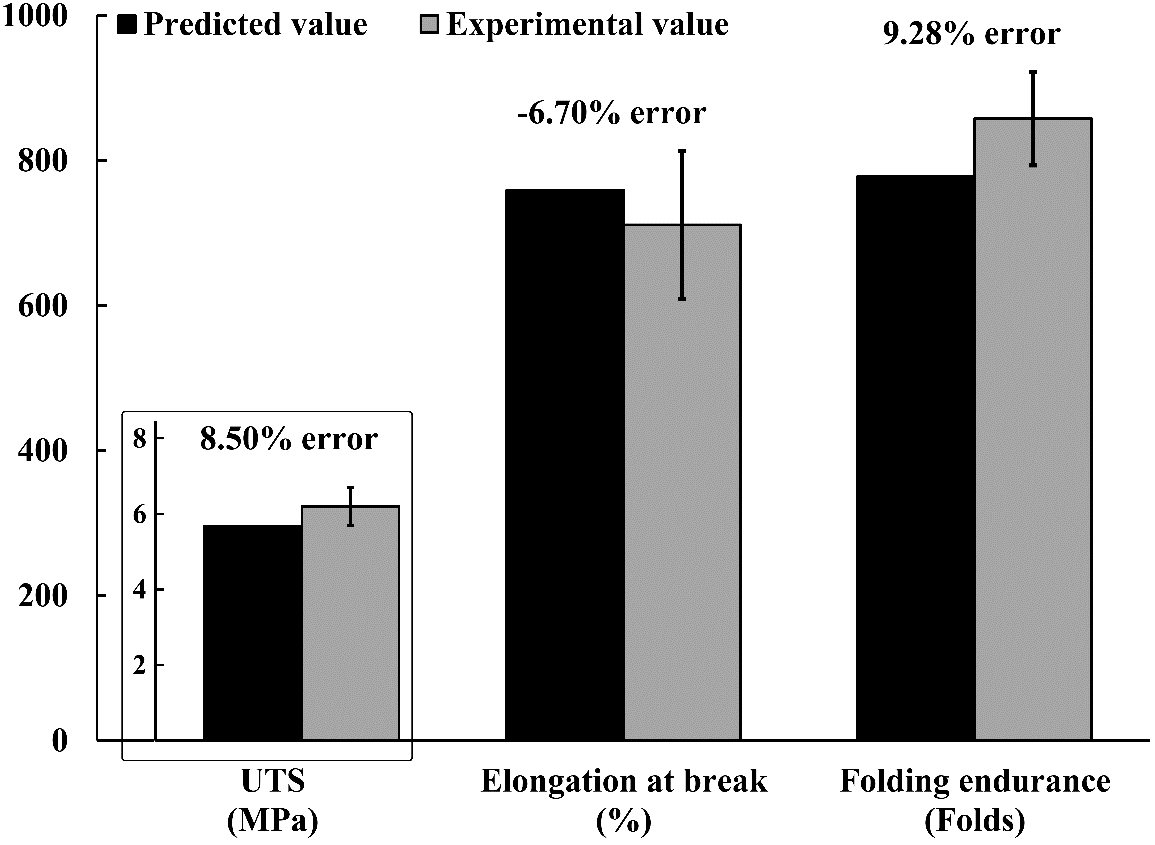Applying Design of Experiments on the Mechanical Properties of Mefenamic Acid-Loaded Transdermal Films
DOI:
https://doi.org/10.48048/tis.2023.7065Keywords:
Applying design of experiments, Mechanical properties, Mefenamic acid, Transdermal filmsAbstract
The Design-Expert® program version 11 was used to analyze and optimize the mechanical properties of mefenamic acid-loaded transdermal films. The dependent variables were ultimate tensile strength (UTS), elongation at break and folding endurance, whereas the independent variables were silicone rubber, mefenamic acid and dibutyl sebacate (DBS). While quadratic models predicted elongation at break and folding endurance more accurately, a linear model predicted the highest correlation relationship for UTS. The design of experiments (DOE) estimated that the optimal silicone rubber, mefenamic acid and DBS ratio would be 5.3:2.5:5.2. By demonstrating that the prediction value of the ratio was more than 4, the model was proved to be suitable for forecasting results inside the design space without the requirement for additional trials. Experimental values of UTS, elongation at break and folding endurance were 6.20 ± 0.50 MPa, 711.22 ± 102.00 % and 857 ± 64 folds, respectively. The percent error was determined to be 8.50, 6.70 and 9.28 %, respectively. The DOE successfully demonstrated a low percent error of prediction (less than 10 %) from the Design-Expert® approach, which was satisfactory and accepted for preparation in drug delivery systems.
HIGHLIGHTS
- Transdermal film formulations containing mefenamic acid had been optimized and enhanced
- As polymer matrix and plasticizer, silicone rubber and dibutyl sebacate were utilized, respectively
- While quadratic models predicted more correctly elongation at break and folding endurance, a linear model predicted the greatest correlation relationship for ultimate tensile strength
- Ultimate tensile strength, elongation at break and folding endurance experimental values were 20 ± 0.50 MPa, 711.22 ± 102.00 % and 857 ± 64 folds, respectively
- Less than 10 % was successfully demonstrated, which was enough and acceptable
GRAPHICAL ABSTRACT
Downloads
Metrics
References
AZ Hezave, MH Khademi and F Esmaeilzadeh. Measurement and modeling of mefenamic acid solubility in supercritical carbon dioxide. Fluid Ph. Equilib. 2012; 313, 140-7.
SM Alshehri, JB Park, BB Alsulays, RV Tiwari, B Almutairy, AS Alshetaili, J Morott, S Shah, V Kulkarni, S Majumdar, ST Martin, S Mishra, L Wang and MA Repka. Mefenamic acid taste-masked oral disintegrating tablets with enhanced solubility via molecular interaction produced by hot melt extrusion technology. J. Drug Deliv. Sci. Technol. 2015; 27, 18-27.
J Suksaeree, K Piamsap, S Paktham, T Kenprom, C Monton and W Pichayakorn. Formulation development of matrix type transdermal patches containing mefenamic acid: Physicochemical characterization and in vitro release evaluation. Monatsh. Chem. 2017; 148, 1215-22.
SV Kumar, P Tarun and TA Kumar. Formulation optimization and characterization of transdermal patch of mefenamic acid. Indo Am. J. Pharm. Res. 2013; 3, 4269-78.
J Suksaeree, P Siripornpinyo and S Chaiprasit. Formulation, characterization, and in vitro evaluation of transdermal patches for inhibiting crystallization of mefenamic acid. J. Drug Deliv. 2017; 2017, 7358042.
L Fang, S Numajiri, D Kobayashi and Y Morimoto. The use of complexation with alkanolamines to facilitate skin permeation of mefenamic acid. Int. J. Pharm. 2003; 262, 13-22.
C Monton and J Suksaeree. Modelling mechanical properties of topical films containing Ganoderma applanatum using the design of experiments. Trends Sci. 2023; 20, 6485.
S Shirisha, G Joshi, SK Sahoo and YM Rao. Preparation and evaluation of matrix type transdermal patches of domperidone maleate: In vitro and ex vivo characterization. Indian J. Pharm. Educ. Res. 2017; 51, 517-24.
R Waiprib, P Boonme, W Taweepreda, E Kalkornsurapranee, J Suksaeree and W Pichayakorn. Deproteinized natural rubber latex/gelatinized starch blended films as drug delivery carrier. Monatsh. Chem. 2017; 148, 1223-8.
TS Anirudhan, SS Nair and AS Nair. Fabrication of a bioadhesive transdermal device from chitosan and hyaluronic acid for the controlled release of lidocaine. Carbohydr. Polym. 2016; 152, 687-98.
JH Kim, SI Kim, IB Kwon, MH Kim and JI Lim. Simple fabrication of silver hybridized porous chitosan-based patch for transdermal drug-delivery system. Mater. Lett. 2013; 95, 48-51.
Y Sampaopan and J Suksaeree. Formulation development and pharmaceutical evaluation of Lysiphyllum strychnifolium topical patches for their anti-inflammatory potential. AAPS PharmSciTech 2022; 23, 116.
P Maneewattanapinyo, C Monton, W Pichayakorn, N Dangmanee, T Wunnakup and J Suksaeree. Plaster gel loaded with silver nanoparticle-mediated Ganoderma applanatum: From fabrication to evaluation. AAPS PharmSciTech 2023; 24, 105.
P Maneewattanapinyo, W Pichayakorn, C Monton, N Dangmanee, T Wunnakup and J Suksaeree. Effect of ionic liquid on silver-nanoparticle-complexed Ganoderma applanatum and its topical film formulation. Pharmaceutics 2023; 15, 1098.
W Pichayakorn, C Monton, Y Sampaopan, K Panrat and J Suksaeree. Fabrication and characterization of buccal film loaded self-emulsifying drug delivery system containing Lysiphyllum strychnifolium stem extracts. AAPS PharmSciTech 2022; 23, 194.
R Gottipati and S Mishra. Process optimization of adsorption of Cr(VI) on activated carbons prepared from plant precursors by a two-level full factorial design. Chem. Eng. J. 2010; 160, 99-107.
S Costa, M Barroso, A Castañera and M Dias. Design of experiments, a powerful tool for method development in forensic toxicology: Application to the optimization of urinary morphine 3-glucuronide acid hydrolysis. Anal. Bioanal. Chem. 2010; 396, 2533-42.

Downloads
Published
How to Cite
Issue
Section
License
Copyright (c) 2023 Walailak University

This work is licensed under a Creative Commons Attribution-NonCommercial-NoDerivatives 4.0 International License.






